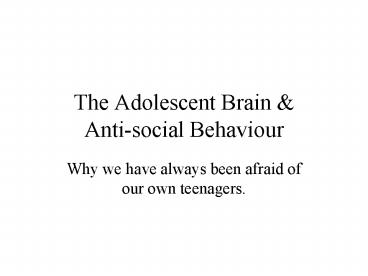The Adolescent Brain - PowerPoint PPT Presentation
1 / 17
Title:
The Adolescent Brain
Description:
USA: ~35% arrests of teenagers. Peak male ~18yrs. Pattern seen cross-culturally. ... Offences like joy-riding why? Offences ... Juvenile Death Row inmates: ... – PowerPoint PPT presentation
Number of Views:34
Avg rating:3.0/5.0
Title: The Adolescent Brain
1
The Adolescent Brain Anti-social Behaviour
- Why we have always been afraid of our own
teenagers.
2
Outline
- Teenage males ASB
- Adolescence Limited criminality
- Brain development, mind behaviour
- Evolutionary perspective
- Adolescent brain development
- The prefrontal cortex
- Conclusion
3
Teenage Males ASB
- Lecture focus on
- Adol. Limited Male ASB.
- M crime 7 x F. (More for more serious crimes.)
- 66 UK crime by under-25s.
- 50 by under-20s.
- USA 35 arrests of teenagers.
- Peak male 18yrs. Pattern seen cross-culturally.
4
Adolescence Limited Criminality
- Criminalitytendency to crime.
- Offences often for drug needs.
- Offences like joy-riding why?
- Offences like fighting why?
- Reflect traits like thrill-seeking.
- So common need normal explanation.
- Different pasts, traits biology to Life Course
Persistent.
5
Brain Development, Mind, Emotions Behaviour.
- Brain develops by growthgtpruning (by
experience)gtfixing (by myelination). - Earlier processes can pre-prepare brain.
- Change in teens sweeps from back to front.
- All about us involves biology.
- If we change, our biology has changed.
- Massive teenage changes gt big brain changes.
6
Evolutionary Perspective
- MACC most accepted fact in criminology.
- See same curve for art, jazz, science, etc.
- All fall off after marriage family.
- Fair match to Testosterone levels.
- Rise as puberty ends, falls from 25yrs.
- M compete for status, f prefer high status.
- Any practical use? (YES!)
7
Age-Crime Curve
8
Age-Scientific Paper Curve
9
Adaptive Brain Changes
- Is most ASB just competition?
- Seems M compete, F prefer high status.
- Puberty gt 10 x rise in T in Males.
- Teenage M high novelty seeking competitiveness
impulsivity aggression sex drive thrill
seeking. Low empathy. - Good for winning status gt mate choice.
- More delinquent inner-city M, more kids.
- Many murderers young M disrespected in front of
peers.
10
Teenage Development Outline
- Some changes sleep patterns sex emotions
morality less reward social. - Grey matter increase in metabolism pre-birth to
12yrs. - GM declines from 12 to 20yrs.
- Decline lost synapses more myelination
- Overall PFC metabolism increases to 10yr
- Decreases to adult levels by 18yrs.
- Double focussing gt better efficiency.
11
Brain Development
- Corpus callosum grows 2 a yr in teens.
- Parietal grey matter drops from 11yrs.
- Temporal GM rise until 17yrs.
- Occipital GM increases up to early 20s.
- Also many subcortical changes.
- Dopamine system changes gt need stronger rewards.
- Hormones trigger experience sculpts.
12
The Prefrontal Cortex 1
- PFC has key functions central executive
morality empathy impulsivity emotional
control etc. - PFC takes control of primitive areas like
amygdala, teens worse than kids or adults. - PFC in psychopaths like extreme teens?
- Abuse, drugs, alcohol gt unusual changes.
13
Adolescent Pruning
14
Prefrontal Cortex 2
- Immature PFC nucleus accumbens gtreward
insensitivity gtgambling drugs - Executive areas late maturinggtbad decisions.
Seen on EEG too. - Behavioural control areas immature gt High
Impulsivity gt ASB. - Moral systems empathy matures past 20. OFC
also mirror neuron networks.
15
Example Orbitofrontal cortex
- Scans show link to moral behaviour.
- 2 cases injured OFC lt16 monthsgt psychopaths.
Couldnt learn rules. - Paedophiles 4 had underactive PFC.
- One teacher gt paedophile, etc when OFC tumour.
Came went with tumour. - Frontotemporal dementiagt ASB.
- Frontal damage in kids/teensgtASB.
16
Biosocial Interactionism
- Juvenile Death Row inmates
- 74 grew up in dysfunctional families 60
suffered abuse or severe neglect 43 had
diagnosed psychiatric disorders (this includes
ADHD, conduct disorder, schizophrenia and
others) 38 were addicted to drugs or alcohol
38 lived in poverty. - Biology interacts with environment no sense in
putting one first.
17
Conclusion
- The PFC holds systems key to ASB.
- Adolescent males evolved to compete.
- Teen brain suits competition.
- Teens lack judgement, impulse control empathy
to be as responsible as adults. - Need other ways to compete in risky acts.
- Must consider with environment.































![[PDF] DOWNLOAD El cerebro del adolescente [The Adolescent Brain]: Desc PowerPoint PPT Presentation](https://s3.amazonaws.com/images.powershow.com/10083646.th0.jpg?_=20240723069)